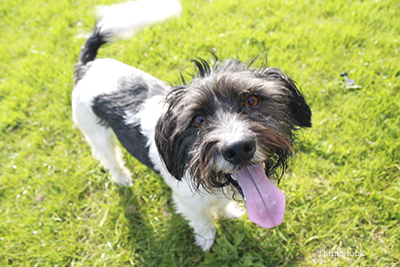
Have you ever been around a large, muscular, happy dog who upends flower vases and knocks over beverages on coffee tables with his vigorously wagging tail? Ever been repeatedly slapped across the thighs by one of these wagging whips, and the more you react to the pain the more the dog wags? Ouch! People living with these happy waggers must often “tail-proof” their homes and protect their guests!
Can tail wagging be a canine health issue?
Such vigorous tail wagging can indeed result in problems for the dog. By repeatedly whacking his tail against a firm surface such as wall or a table, an open bleeding sore can develop on the tail tip. The dog’s response is to lick and chew at the site — resulting in even more inflammation and bleeding. This tail tip trauma isn’t typically terribly painful for the dog so, of course the tail keeps right on wagging. Only now it’s a live paintbrush spattering speckles of red on the walls, furniture, kitchen appliances, and even nearby humans! The end result can be as graphic as a CSI crime scene.
Medical therapy for a damaged tail
One could think this would be a simple problem to fix. The fact of the matter is, a bleeding tail tip poses a significant medical challenge. In order to heal, the tail must be relatively immobilized. There are some clever ways to secure the tail between the hind legs or adjacent to the outside of a hind leg; however, most dogs (and most clients) don’t tolerate this well. The same holds true for bandages applied to the tail tip. Most dogs simply chew them off, and Elizabethan collars aren’t large enough to prevent the tongue from reaching the tip of the tail. Besides, even if the tail tip does heal, the dog is likely to re-whack it and the bleeding will start all over again.
Behavioral therapy to stop the wagging
Behavior modification may provide an effective solution, particularly for dogs who are wagging exuberantly because of anxiety or a strong desire to appease those in their environment. The goal is to create a calmer, less anxious dog and it requires patience, consistency and help from a knowledgeable dog trainer.
Surgical therapy to stop the wagging
Radical as it may sound, surgical removal of the end of the tail is often the treatment of choice, particularly if behavior modification and/or medical therapy fail to solve the problem. The tail revision (partial amputation) need not need be as short as a Rottweiler look. Rather, the finished surgical product might resemble an Airedale or Vizsla — still some tail, but short enough to prevent the wagging tip from coming into contact with hard surfaces. Yes, the look of the dog is forever changed, but the wag will continue as vigorously as ever without ever again altering the color of the wallpaper or injuring the dog.
Questions for your veterinarian
- Do you think that behavioral modification might be of benefit? If so, is there a trainer you recommend I work with on this?
- What type of medical therapy do you recommend for tail tip trauma?
- If surgical tail revision is needed, what will this involve?
If you have any questions or concerns, you should always visit or call your veterinarian -- they are your best resource to ensure the health and well-being of your pets.
